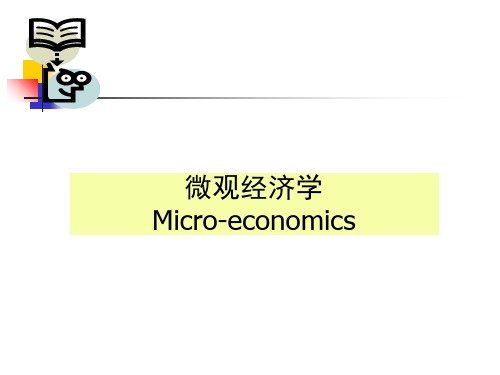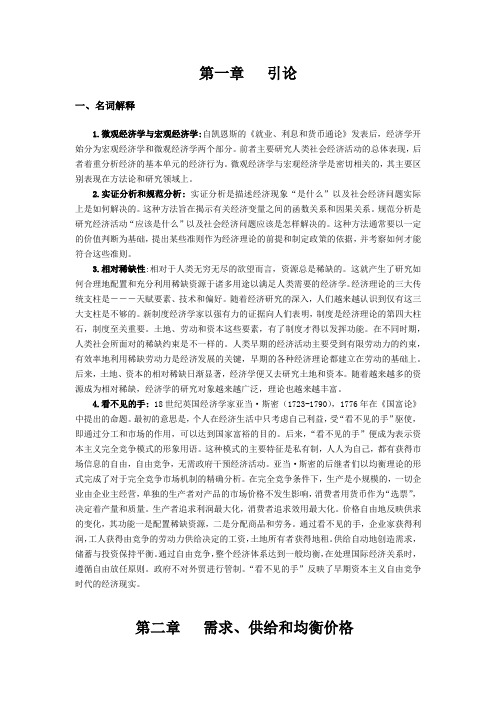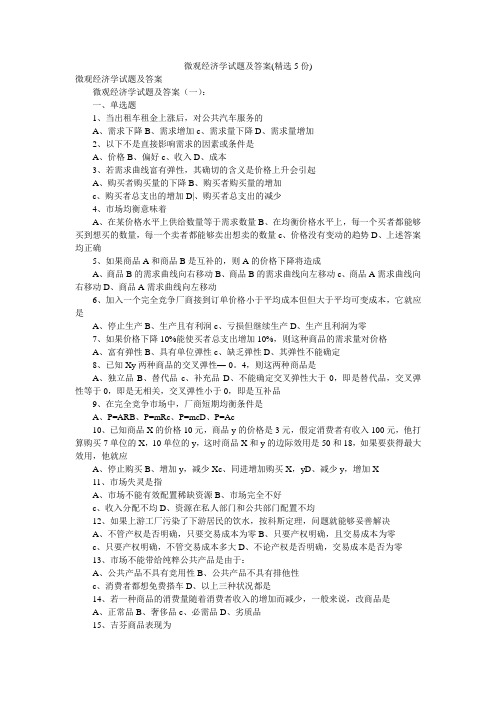微观经济学一
微观经济学作业1~4 完整答案

微观经济学作业一(导论与市场运行)一、选择题(将正确答案的标号填在题后的括号里)1.在任何一个经济中:( C )A、因为资源是稀缺的所以不会存在资源的浪费B、因为存在资源浪费,所以资源并不稀缺C、既存在资源稀缺,又存在资源浪费2.资源的稀缺性是指:( B )A、世界上的资源最终会由于人们生产更多的物品而消耗光B、相对于人们无穷的欲望而言,资源总是不足的C、生产某种物品所需资源的绝对数量很少3. 微观经济学解决的问题是:( A )A、资源配置B、资源利用C、单个经济单位如何实现最大化【微观经济学以单个经济单位为研究对象,通过研究单个经济单位的经济行为来说明市场经济如何通过价格机制来解决社会资源配置问题。
微观经济学对于居民的研究,是以居民如何将有限收入用于各种物品的消费上实现效用最大化而展开的。
微观经济学对厂商的研究是从厂商如何将有限资源用于生产实现利润最大化而展开的。
微观经济学通过对居民的效用最大化和厂商的利润最大化的研究,来探索整个社会的资源最优配置。
每个经济单位都实现了最大化,整个社会的资源配置也就达到最优化了。
】4. 宏观经济学的基本假设是:( B )A、市场出清B、市场失灵C、完全理性5. 实证经济学与规范经济学的根本区别是:( A )A、研究方法的不同B、研究对象的不同C、研究范围的不同【实证经济学和规范经济学是现代经济学的两个重要分支,是学术界对因研究方法的不同而对经济学的一种划分。
】6. 当汽油的价格上升时,小汽车的需求将:( A )A、需求曲线向左移动B、保持不变C、需求曲线向右移动【互补品】7. 当咖啡的价格急剧上升时,对茶叶的需求将:( C )A、减少B、保持不变C、增加【替代品】8.消费者预期某物品将来价格要上升,则对该物品当前需求会:( C )A、减少B、不变C、增加9.需求的变动与需求量的变动:( C )A、是一回事B、都是由于同一种原因引起的C、需求的变动由除价格以外的其它因素的变动引起的,而需求量的变动由价格的变动引起10.对化妆品需求的减少是指( A )A、收入减少而引起的减少B、价格上升而引起的减少C、与需求量的减少相同11.需求曲线通常是一条:( A )A、向右下方倾斜的曲线B、向左下方倾斜的曲线C、垂线12.在同一条需求曲线上,价格与需求量的组合从A点移动到B点是:( C )A、需求的变动B、收入的变动C、需求量的变动13. 鸡蛋的供给量增加是指:( B )A、由于鸡蛋的需求量增加而引起的增加B、由于鸡蛋的价格上升而引起的增加C、由于收入的增加而引起的增加14. 均衡价格是:( A )A、供给与需求相等时的价格B、固定不变的加格C、任何一种市场价格15. 均衡价格随着( C )。
《微观经济学》PPT课件

〔2〕比较静态分析法:只分析 始点和终点的经济变量的 状 况
〔3〕动态分析法 引入时间因 素,分析某一时期内经济变量 的过程状况 .
三、经济模型
1、 经 济 模 型 〔economic
model>:用来表述经济
P price
变量之间的依存关系的理
李嘉图发展了亚当、斯密的思想,建立起了以劳动价 值论为基础,以分配论为中心的理论体系.并提出了 比较成本学说.他认为:每个国家都可以通过生产具 有相对优势的商品,通过国际贸易获得利益.
3、萨伊<Say>〔法〕 〔1767-1832〕
让·巴蒂斯特·萨伊
代表作《政治经济学概论》1803年
他认为:供给创造需求,储蓄必然转化 为投资,生产就是消费,供给就是需求, 生产过剩的危机是不会发生的.一个 国家生产者越多,产品越多,企业越多, 贸易越多社会财富越多.主张发展生 产.
2、按研究经济问题判断标准的不同可分为:
• 实证经济学<positive economics>:用事 实说明经济现象的现状如何?回答是什么 〔What is>如:某一时期的经济增长率为 8%,失业率是6%.
•规范经济学<normative economics>:以一 定的判断标准为出发点,力求回答应该是 什么〔What ought to be>.如:要实现8%的 年经济增长速度,政府应采取什么样的财 政政策和货币政策.某国的收入分配是不 是公平.
亚当、斯密的《国富论》
在《国富论》的序论中的第一句话就是: "被看作政治家或立法家的一门政治经济学 提出两个目标: 第一,给人民提供充足的收入或生计, 第二,给国家或社会提供充足的收入. 总之,其目的在于富国裕民".
微观经济学-名词解释(全)

第一章引论一、名词解释1.微观经济学与宏观经济学:自凯恩斯的《就业、利息和货币通论》发表后,经济学开始分为宏观经济学和微观经济学两个部分。
前者主要研究人类社会经济活动的总体表现,后者着重分析经济的基本单元的经济行为。
微观经济学与宏观经济学是密切相关的,其主要区别表现在方法论和研究领域上。
2.实证分析和规范分析:实证分析是描述经济现象“是什么”以及社会经济问题实际上是如何解决的。
这种方法旨在揭示有关经济变量之间的函数关系和因果关系。
规范分析是研究经济活动“应该是什么”以及社会经济问题应该是怎样解决的。
这种方法通常要以一定的价值判断为基础,提出某些准则作为经济理论的前提和制定政策的依据,并考察如何才能符合这些准则。
3.相对稀缺性:相对于人类无穷无尽的欲望而言,资源总是稀缺的。
这就产生了研究如何合理地配置和充分利用稀缺资源于诸多用途以满足人类需要的经济学。
经济理论的三大传统支柱是---天赋要素、技术和偏好。
随着经济研究的深入,人们越来越认识到仅有这三大支柱是不够的。
新制度经济学家以强有力的证据向人们表明,制度是经济理论的第四大柱石,制度至关重要。
土地、劳动和资本这些要素,有了制度才得以发挥功能。
在不同时期,人类社会所面对的稀缺约束是不一样的。
人类早期的经济活动主要受到有限劳动力的约束,有效率地利用稀缺劳动力是经济发展的关键,早期的各种经济理论都建立在劳动的基础上。
后来,土地、资本的相对稀缺日渐显著,经济学便又去研究土地和资本。
随着越来越多的资源成为相对稀缺,经济学的研究对象越来越广泛,理论也越来越丰富。
4.看不见的手:18世纪英国经济学家亚当·斯密(1723-1790),1776年在《国富论》中提出的命题。
最初的意思是,个人在经济生活中只考虑自己利益,受“看不见的手”驱使,即通过分工和市场的作用,可以达到国家富裕的目的。
后来,“看不见的手”便成为表示资本主义完全竞争模式的形象用语。
这种模式的主要特征是私有制,人人为自己,都有获得市场信息的自由,自由竞争,无需政府干预经济活动。
微观经济学01引论例题

张元鹏《微观经济学》第一篇微观经济学导论1.判断题(1)任何不对其索取价格的物品都是自由取用物品。
()【答案】×【解析】自由取用物品是指相对于人类的欲望来说,其数量是无限的,取用时不需要花费任何代价,其价格为零,如自然界中的空气、水等。
但是不对其索取价格并不代表都是自由取用物品,如得到免费馈赠的物品,对于被赠与人来说未被索取任何价格,但该物品仍是经济物品。
(2)稀缺物品一定有一个直接以货币支付的价格。
()【答案】×【解析】稀缺物品是指相对于人类无限多样性的需要或欲望而言,其数量是有限的,取用时需要付出一定的代价,其机会成本大于零。
但不是所有的稀缺性都可以用货币来表示。
例如,随着工业的发展和环境污染,清洁的水和新鲜的空气逐渐变得稀缺,但难以用货币来衡量。
(3)如果你得到两张免费的奥运会参观券,它们可以看作是自由取用物。
()【答案】×【解析】自由物品的免费取用是对于所有社会成员而言的,奥运会参观券对于其他人来说,仍需支付一定的价格,所以是稀缺物品。
(4)如果某种资源免费供应时社会成员所需要的多于现有的,那么,这种资源就是稀缺的。
()【答案】√【解析】当某种资源免费供应社会成员所需要的多于现有的,便出现了资源的有限性与欲望的无限性的矛盾,从而这种资源是稀缺的。
(5)说一种理论是实证的,并不意味着它必然是正确的。
()【答案】√【解析】实证分析是描述经济现象“是什么”以及社会经济问题实际上是如何解决的,是在一定的假定及考虑有关经济变量间因果关系的前提下,描述、解释或说明已观察到的事实,对有关现象将会出现的情况做出预测。
(不讲价值判断)但经济学家在分析、寻求经济活动的客观规律时,不可避免地受到其个人的经济地位、价值观念等的影响,个人的价值判断会不自觉地对实证分析产生影响。
实证分析中关于人的行为的社会认识是其分析的基础,完全的客观主义是不存在的,因而实证分析得出的理论也就不必然是正确的。
微观经济学习题1

微观经济学习题1微观经济学习题(一)一、选择题1、经济学可被定义为()A、政府对市场的干预B、企业取得利润的活动C、研究如何最合理地配置稀缺资源于多种用途D、人们靠收入生活2、“资源的稀缺”是指( )A、世界上大多数人生活在贫困中B、相对于资源的需求而言,资源总是不足的C、资源必须保留给下一代D、世界上资源最终将由于生产更多的物品和劳务而消耗光3、经济学研究的基本问题是( )A、如何生产B、生产什么,生产多少C、为谁生产D、以上都包括4、以下问题中哪一个不是微观经济学所考察的问题( )A、一个厂商的生产水平B、失业率的上升或下降C、政府货物税的高税率对货物销售的影响D、某一行业中雇佣工人的数量5、在得出某种商品的个人需求曲线时,下列因素除哪一种外均保持为常数( )A、个人收入B、其他商品的价格C、个人偏好D、所考虑商品的价格6、保持所有其他因素不变,某种商品的价格下降,将导致( )A、需求增加B、需求减少C、需求量增加D、需求量减少7、其他条件不变,消费者预期某种物品未来价格要上升,则对该物品当前需求会( )A、减少B、增加C、不变D、上述三种情况都可能8、所有下列因素除哪一种外都会使需求曲线移动( )A、消费者收入变化B、商品价格下降C、其他商品价格下降D、消费者偏好变化9、如果商品A和商品B是替代的,则A的价格下降将导致( )A、A的需求曲线向左移动B、B的需求曲线向左移动C、A的需求曲线向右移动D、B的需求曲线向右移动10、一个商品价格下降对其互补品最直接的影响是( )A、互补品的需求曲线向右移动B、互补品的需求曲线向左移动C、互补品的供给曲线向右移动 C、互补品的供给曲线向左移动11、建筑工人工资提高将使( )A、新房子供给曲线左移并使房子价格上升B、新房子供给曲线右移并使房子价格下降 D、新房子需求曲线右移并使房子价格上升12、小麦歉收导致小麦价格上升,准确地说在这个过程中( )A、小麦供给减少引起了需求量下降B、小麦供给减少引起了需求下降C、小麦供给量减少引起了需求量下降D、小麦供给量减少引起了需求下降13、政府把价格限制在均衡价格以下可能导致( )A、黑市交易B、大量积压C、买者按低价买到了希望购买的商品数量D、A和C14、如果消费者对某种商品的偏好突然增加,同时这种商品的生产技术有很大改进,我们可以预料()A、该商品的需求曲线和供给曲线向右移动并使均衡价格和均衡产量提高;B、该商品的需求曲线和供给曲线向右移动并使均衡价格和均衡产量降低;C、该商品的需求曲线和供给曲线向左移动并使均衡价格上升而均衡产量下降;D、该商品的需求曲线和供给曲线向右移动并使均衡产量增加,但均衡价格可能上升也可能下降;15 、其他条件不变,如果生产者预期某种商品未来价格要下降,则对该商品当前的供给会()A 增加B 减少C 不变D 上述三种情况都可能16、某消费者的收入下降,而他对某种产品的需求却增加了,则该产品属于()A低档产品B互补产品C高档产品 D 互替产品17、某商品的需求函数为Q=12000 —25P,在需求数量为2000件时的需求点弹性是()A 25B 10C 5D 118、如果某种商品的需求收入弹性为正值,说明该商品()A 不是低档商品B 是生活必需品C 是高档商品D 是低档商品19、如果价格下降10%可以使购买者的需求量增加11%,说明该商品的需求量对价格()A 富有弹性B 具有单一弹性C 缺乏弹性D 不能确定20、如果需求交叉弹性等于-3,说明两种商品的关系是()A独立品 B 互补品 C 替代品 D 不能确定21、一般来说,某种商品的需求价格弹性与购买该商品的支出占全部支出的比例的关系是()A 购买该商品的支出占全部支出的比例越大,其需求弹性就越大B 购买该商品的支出占全部支出的比例越大,其需求弹性就越小C 购买该商品的支出占全部支出的比例越小,其需求弹性就越大D 购买该商品的支出占全部支出的比例越小,其需求弹性就越小22 、某商品的需求价格是100元,需求数量是100件,价格下降到80元,需求数量没有发生变化,还是100件,说明该商品的需求价格弹性()A等于1 B 等于-1 C 等于0 D 不能确定23、如果某商品的市场需求函数为D=30—P,市场供给函数为S=3P—10,,如果对该商品的生产者实行减税,则减税后的市场均衡价格()A 等于10B 小于10C 大于10D 不能确定24、某些人在收入比较低时购买黑白电视机,而在收入提高时,则去购买彩色电视机,黑白电视机对这些人来说( )A、生活必需品B、奢侈品C、劣质商品25、如果人们收入水平提高,则食物支出在总支出中比重将( )A、大大增加B、稍有增加C、下降D、不变26、某商品的供给曲线是一条通过原点的直线,则该供给曲线的供给弹性是()A随价格的变化而变化 B恒为1 C不可固定 D等于曲线得斜率27、蛛网模型以()为假定前提A需求量变动存在时滞B生产者按照本期价格决定下一期的供给量C需求量对价格缺乏弹性 D供给量对价格缺乏弹性28、假定玉米市场的需求是缺乏弹性的,玉米的产量等于销售量且等于需求量,恶劣的气候条件使玉米产量下降20%,在这种情况下,()。
微观经济学大一试题及答案

微观经济学大一试题及答案一、选择题(每题2分,共20分)1. 需求定律表明,其他条件不变时,商品的价格上升,其需求量将:A. 增加B. 减少C. 不变D. 先增加后减少答案:B2. 完全竞争市场中,厂商的短期供给曲线是:A. 边际成本曲线B. 平均成本曲线C. 总成本曲线D. 固定成本曲线答案:A3. 以下哪项不是市场失灵的原因?A. 公共品B. 外部性C. 垄断D. 消费者偏好答案:D4. 边际效用递减原理指的是:A. 随着消费量的增加,消费者对商品的总效用逐渐增加B. 随着消费量的增加,消费者对商品的边际效用逐渐减少C. 随着消费量的增加,消费者对商品的总效用逐渐减少D. 随着消费量的增加,消费者对商品的边际效用保持不变答案:B5. 价格弹性的计算公式是:A. 价格变化百分比 / 需求量变化百分比B. 需求量变化 / 价格变化C. 价格变化 / 需求量变化D. 价格变化百分比 * 需求量变化百分比答案:A6. 以下哪项不是生产要素?A. 土地B. 劳动C. 资本D. 产品答案:D7. 消费者剩余是指:A. 消费者实际支付的金额B. 消费者愿意支付的金额与实际支付金额之间的差额C. 消费者从购买中获得的总效用D. 消费者剩余与生产者剩余之和答案:B8. 完全垄断市场中,厂商的供给曲线是:A. 垂直的B. 向右上方倾斜的C. 向右下方倾斜的D. 水平的答案:B9. 以下哪项不是市场均衡的特征?A. 市场价格等于边际成本B. 市场供给量等于市场需求量C. 市场价格等于平均成本D. 厂商没有利润答案:D10. 以下哪项不是消费者偏好的假设?A. 完备性B. 传递性C. 一致性D. 随机性答案:D二、简答题(每题10分,共30分)1. 简述边际效用递减原理及其对消费者行为的影响。
答:边际效用递减原理指的是随着消费者对某一商品消费量的增加,从每增加一单位商品中获得的额外满足(即边际效用)逐渐减少。
这一原理对消费者行为的影响主要体现在消费者在有限预算约束下,会倾向于将资源分配到不同商品上,以实现效用最大化。
微观经济学试题及答案(精选5份)

微观经济学试题及答案(精选5份)微观经济学试题及答案微观经济学试题及答案(一):一、单选题1、当出租车租金上涨后,对公共汽车服务的A、需求下降B、需求增加c、需求量下降D、需求量增加2、以下不是直接影响需求的因素或条件是A、价格B、偏好c、收入D、成本3、若需求曲线富有弹性,其确切的含义是价格上升会引起A、购买者购买量的下降B、购买者购买量的增加c、购买者总支出的增加D|、购买者总支出的减少4、市场均衡意味着A、在某价格水平上供给数量等于需求数量B、在均衡价格水平上,每一个买者都能够买到想买的数量,每一个卖者都能够卖出想卖的数量c、价格没有变动的趋势D、上述答案均正确5、如果商品A和商品B是互补的,则A的价格下降将造成A、商品B的需求曲线向右移动B、商品B的需求曲线向左移动c、商品A需求曲线向右移动D、商品A需求曲线向左移动6、加入一个完全竞争厂商接到订单价格小于平均成本但但大于平均可变成本,它就应是A、停止生产B、生产且有利润c、亏损但继续生产D、生产且利润为零7、如果价格下降10%能使买者总支出增加10%,则这种商品的需求量对价格A、富有弹性B、具有单位弹性c、缺乏弹性D、其弹性不能确定8、已知Xy两种商品的交叉弹性—-0。
4,则这两种商品是A、独立品B、替代品c、补充品D、不能确定交叉弹性大于0,即是替代品,交叉弹性等于0,即是无相关,交叉弹性小于0,即是互补品9、在完全竞争市场中,厂商短期均衡条件是A、P=ARB、P=mRc、P=mcD、P=Ac10、已知商品X的价格10元,商品y的价格是3元,假定消费者有收入100元,他打算购买7单位的X,10单位的y,这时商品X和y的边际效用是50和18,如果要获得最大效用,他就应A、停止购买B、增加y,减少Xc、同进增加购买X,yD、减少y,增加X11、市场失灵是指A、市场不能有效配置稀缺资源B、市场完全不好c、收入分配不均D、资源在私人部门和公共部门配置不均12、如果上游工厂污染了下游居民的饮水,按科斯定理,问题就能够妥善解决A、不管产权是否明确,只要交易成本为零B、只要产权明确,且交易成本为零c、只要产权明确,不管交易成本多大D、不论产权是否明确,交易成本是否为零13、市场不能带给纯粹公共产品是由于:A、公共产品不具有竞用性B、公共产品不具有排他性c、消费者都想免费搭车D、以上三种状况都是14、若一种商品的消费量随着消费者收入的增加而减少,一般来说,改商品是A、正常品B、奢侈品c、必需品D、劣质品15、吉芬商品表现为A、需求收入弹性和需求价格弹性都是正值B、需求收入弹性为负,需求价格弹性为正c、需求收入弹性为正,需求价格弹性为负D、需求收入弹性和需求价格弹性都是负值二、作图分析说明题1、作图说明赋税是如何造成经济剩余的无谓损失2、作图说明利率提高是何增加或是减少家庭储蓄的两种图型,并做必须的分析三、计算题1、从甲地到乙地汽车原价为10元,火车的乘客为12万,当汽车的票价由原先的10元减至8。
微观经济学作业1答案

微观经济学作业一(导论与市场运行)一、选择题(将正确答案的标号填在题后的括号里)1.在任何一个经济中:( C )A、因为资源是稀缺的所以不会存在资源的浪费B、因为存在资源浪费,所以资源并不稀缺C、既存在资源稀缺,又存在资源浪费2.资源的稀缺性是指:( B )A、世界上的资源最终会由于人们生产更多的物品而消耗光B、相对于人们无穷的欲望而言,资源总是不足的C、生产某种物品所需资源的绝对数量很少3. 微观经济学解决的问题是:( A )A、资源配置B、资源利用C、单个经济单位如何实现最大化4. 宏观经济学的基本假设是:( B )A、市场出清B、市场失灵C、完全理性5. 实证经济学与规范经济学的根本区别是:( A )A、研究方法的不同B、研究对象的不同C、研究范围的不同6. 当汽油的价格上升时,小汽车的需求将:( A )A、需求曲线向左移动B、保持不变C、需求曲线向右移动7. 当咖啡的价格急剧上升时,对茶叶的需求将:( C )A、减少B、保持不变C、增加8.消费者预期某物品将来价格要上升,则对该物品当前需求会:( C )A、减少B、不变C、增加9.需求的变动与需求量的变动:( C )A、是一回事B、都是由于同一种原因引起的C、需求的变动由除价格以外的其它因素的变动引起的,而需求量的变动由价格的变动引起10.对化妆品需求的减少是指( A )A、收入减少而引起的减少B、价格上升而引起的减少C、与需求量的减少相同11.需求曲线通常是一条:( A )A、向右下方倾斜的曲线B、向左下方倾斜的曲线C、垂线12.在同一条需求曲线上,价格与需求量的组合从A点移动到B点是:( C )A、需求的变动B、收入的变动C、需求量的变动13. 鸡蛋的供给量增加是指:( B )A、由于鸡蛋的需求量增加而引起的增加B、由于鸡蛋的价格上升而引起的增加C、由于收入的增加而引起的增加14. 均衡价格是:( A )A、供给与需求相等时的价格B、固定不变的加格C、任何一种市场价格15. 均衡价格随着( C )。
- 1、下载文档前请自行甄别文档内容的完整性,平台不提供额外的编辑、内容补充、找答案等附加服务。
- 2、"仅部分预览"的文档,不可在线预览部分如存在完整性等问题,可反馈申请退款(可完整预览的文档不适用该条件!)。
- 3、如文档侵犯您的权益,请联系客服反馈,我们会尽快为您处理(人工客服工作时间:9:00-18:30)。
competition. The model is tested by comparing its predictions with actual markets. Economists believe this model can provide answers to the four basic questions:
2013-7-20
Economists do not judge people‘s preferences(偏好). 5
The Basic Competitive Model (cont.)
Profit-Maximizing Firms
For firms; rationality means maximizing profits. Profit = revenue costs. Revenue = pQ. Profit = pQ costs.
rivalrous, and transferable. A combination of freedom and responsibility is crucial to markets.
Freedom: Individuals
and firms must be creative and free to try
2013-7-20
11
Incentives and Information (cont.)
Property Rights
The right of the owner to use and sell his or her property. With well-defined property rights, access is excludable,
2013-7-20
10
Incentives and Information
Income
Income is an incentive for consumers, workers, investors,
and firms. Consumer or household income is personal income. Firm income is revenue, divided between costs and profit.
Since different
people perform differently. If this inequality is from luck, would another criterion of compensation do "better"? Some economists hold equality as a value in its own right.
2013-7-20 14
Incentives and Information (cont.)
When Property Rights Fail
In many cases property rights are not clearly defined. This causes
problems with the efficient allocation of resources.
What is produced, and in what quantities? How are goods produced?
For whom are those goods produced?
Who decides the answers to the first three questions, and how?
2013-7-20 8
The Basic Competitive Model (cont.)
The Basic Competitive Model as a Benchmark
Combines self-interested consumers, profit-maximizing firms, and
2013-7-20
6
The Basic Competitive Model (cont.)
Information Costs
Individuals and firms often make decisions with little or no
information.
Is the car a lemon?
Performance-Based Compensation
Even if pay can be tied to performance, how does one
measure performance? If compensation is tied to performance, this leads to inequality.
Agenda
The basic competitive model Incentives and Information: Prices, Property Rights, and Profits Rationing Opportunity sets and trade offs Costs
Government is not needed to answer these questions in the basic
competitive model.
2013-7-20
9
The Basic Competitive Model (cont.)
Efficiency in the Basic Competitive Model
Rationality applies to acquiring information to answer
7
The Basic Competitive Model (cont.)
Competitive Markets
Many firms selling identical products to many consumers. Firms and consumers are price takers in competitive markets. Firms provide as much output as consumers will buy. Each firm can sell as much as it wants: the size of the firm is small
Pursue what they see as their own self-interest. Weigh costs
and benefits as they see them. If benefits > costs, take the action. However, different people have different interests.
Incentives versus Equality
Well-defined property rights permit incentives to provide
rewards and costs. If rewards are tied to performance, then a problem arises when many people help to produce a good or service.
The government
established a licensing system, which created well-defined property rights.
Who contributed
what? Who are the most productive employees; is the hot salesperson good or just lucky?
2013-7-20 13
Incentives and Information (cont.)
2013-7-20 3
The Basic Competitive Model
Rational consumers Profit-maximizing firms Competitive markets Government is ignored for now.
2013-7-20
4
Week 1 (cont.)
Thinking like an economist
2013-7-20
1
Objectives
Describe the basic competitive model. Understand what factors determine economic incentives. Explain how scarcity and choice for rational consumers and firms in the basic competitive model yield efficient outcomes. Learn the important categories of cost used in economics. 2013-7-20 2
Will the worker be productive? Will the investment
be profitable?
these questions. If the benefit of more information > the cost of acquiring the information, the information is acquired. 2013-7-20
compared to the size of market. If firms charge a price higher than the market price, they lose all their customers. All firms in the industry charge the same price.
